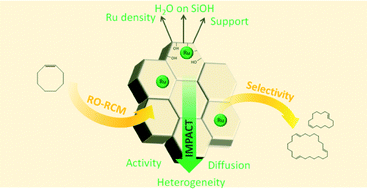Immobilized Grubbs catalysts on mesoporous silica materials: insight into support characteristics and their impact on catalytic activity and product selectivity†
Abstract
Silica materials show a high ability to physisorb the 2nd generation Hoveyda–Grubbs catalyst (HG2) in organic solvents. The interaction with the complex, likely proceeding through hydrogen bonding, is particularly strong with surfaces rich in silanols, wherein geminal silanols show the highest affinity, and therefore mesoporous silicas are the supports of choice. As long as the silica material is sufficiently pure and free of cages, in which high HG2 concentrations can accumulate, the immobilization of HG2 occurs in a very stable manner. Despite the complex stability, exploration of HG2-loaded mesoporous silica supports in metathesis of cis-cyclooctene indicated significant diffusional and confinement effects, and therefore control of pore size, pore architecture and morphology in balance with the intrinsic catalytic activity is essential for catalyst design. As metathesis of cis-cyclooctene apparently proceeds through the initial formation of linear polymers, followed by backbiting forming cyclic oligomers, potential interference of mass transport and space restriction issues is not surprising. This study shows that the catalyst requirements are best met with the TUD-1 silica support (1.24 wt% HG2). Under such conditions, the heterogeneous catalyst performs as good as the homogeneous one, presenting a thermodynamic distribution of cyclic oligomers. The latter catalyst also showed high catalyst stability in a continuous fixed bed reactor, corresponding to a catalytic turnover number of 18 000. The catalytic rates and catalyst stability are lower when operating in a diffusional regime, therefore long reaction times are required to reach the thermodynamic product distribution. Water removal from the catalyst is also important, not because of HG2 stability reasons, but of lower reaction rates which were measured for hydrated samples, likely due to inhibition of cis-cyclooctene uptake in the pores. Mild removal of physisorbed water before immobilization is therefore advised, for instance by thermal treatments, but care has to be taken to keep the silanol density high for firm HG2 immobilization and also to avoid formation of reactive siloxanes, which chemically react with and destroy HG2. Surprisingly, reactive siloxane formation conditions strongly depend on the silica type, with TUD-1 being fairly sensitive to their formation. Finally, the best HG2-loaded TUD-1 catalyst is used successfully in a broad set of other metathesis reactions.

- This article is part of the themed collection: Catalysis on Zeolites

 Please wait while we load your content...
Please wait while we load your content...